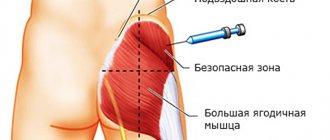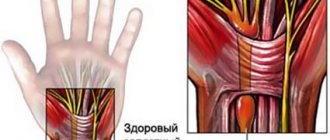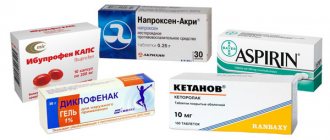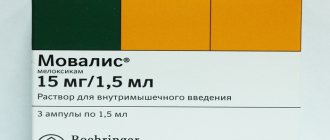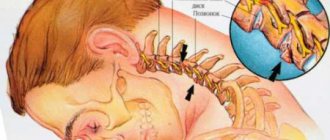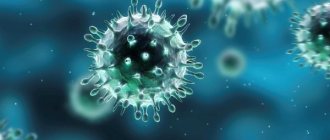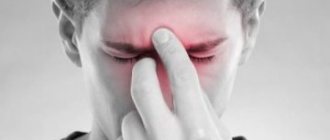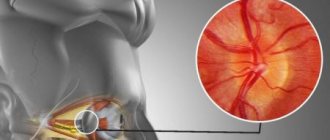There is nothing complicated about these rules. Compliance with them does not take much time and effort, but gives a good preventive result.
Classic treatment will eventually relieve symptoms and put the patient back on his feet. But by eliminating the pain, we do not eliminate its cause, which means the disease may return. Practice shows that repeated manifestations of intercostal neuralgia occur quite often. This is understandable; if the cause is not eliminated, the disease will return.
A serious disadvantage of classical treatment is the need to use medications with serious side effects. But one of the causes of nerve inflammation may be drug intoxication. It turns out to be a vicious circle. The drugs relieve pain, but at the same time increase the likelihood of relapses.
ul
Distinctive features of a pinched nerve
When a nerve is pinched, patients often compare the sensation as if “a stake was stuck into the body.” If sudden acute pain in the sternum occurs, it is necessary to call a medical team to rule out myocardial infarction with similar symptoms.
A pinched intercostal nerve differs from a heart attack by muscle spasms, pale skin, loss of sensation in the affected area, and constant burning pain. It is noteworthy that with neuralgia the pain is one-sided and cannot be relieved by taking Validol or Nitroglycerin.
Most popular this month
Register Login. Mail replies. Questions are leaders. Throat problems for 1 year now. Is it appendicitis or poisoning? How to take Undevit correctly? Blister on gum 1 rate. Pains when pressed in the epigastric area 1 rate. Leaders in the category Lena-foam Artificial Intelligence. Vlad Oracle. Alina Doroh Pupil 17, closed 7 years ago. Best answer. Lyubava Enlightened 7 years ago For intercostal neuralgia, I do this: - you need to take a very deep breath of air into your lungs, open your chest wide, hold your breath for as long as you can stand it, then slowly exhale the air through your lips, folded in a tube, slowly, slowly.
Slowly the chest drops. Thus, when the chest expands, the nerve that is compressed by the surrounding tissue is released. This is how I save myself on the advice of a good neurologist about pain.
I would like to add that with intercostal neuralgia it is rare, but there is temporary complete paralysis of the body. Usually at night, when a person is sleeping, he wakes up from a sharp pain in the chest, usually on the left side - the nerve is compressed by the surrounding tissues and squeezes it - the person wakes up and realizes that he cannot move at all. There is no need to be afraid of this. By morning the temporary paralysis subsides. For example, this happened to me. I didn’t call an ambulance, I really don’t like hospitals. In the morning everything went away.
I went to the cardiologist in the morning, they did a cardiogram - my heart was normal. Other answers. Lacostik Master 7 years ago If it’s not the first time, and now it doesn’t go away, go to the doctor. Ruslan Khabibullin Expert 7 years ago If you managed to type this message, then don’t be lazy and call the doctors.
This is no joke! Dmitry Kovalev Master 7 years ago vertebrologist to help. Nikolay Bashmakov Student 4 years ago Ruslan Khabibullin. Bayan This is all This is neuralgia and there are also lumbago and electric shock to the heart, others and even Infectious diseases of the Nervous system! Dmitry Kovalev vertebrologist Will help in the best way when a person has been fully examined! ROBI Expert 3 years ago definitely see a doctor.
Andrey Korshunov Master 3 years ago it helped: take a deep breath and exhale slowly. Anna Motornaya Student 2 years ago Lyubava, thank you. Your advice was very helpful. Pay attention to your posture, pull yourself together, do the following exercises: “kitty” while standing on all fours, lower your head to the floor and then stretch your back to the floor and lift yourself up on your hands like a cat pulls itself up after lying down, a fish on land lying down on its stomach, raise your arms and legs at the same time, standing on your feet and hands with your back to the floor like a turtle, you make movements with your groin up, the spine weakens, then the doctor recommends it, then I bought a book, these exercises were indicated there..
All the best. Denis Chistyakov Student 2 years ago Oh thank you, it was very helpful! I often have this, so ointment or painkillers help. Violetta Mironova Student 2 years ago Inhale air very deeply into your lungs, open your chest wide, hold your breath for 10 seconds or more, as long as you can stand it, then slowly exhale the air through your lips, slowly, slowly. The chest expands.
Thus, when the chest expands, the nerve is released. The doctor suggested. Alexey Selivanov Student 1 year ago Listen to Lyuba and everything will pass. NT Profi 1 year ago Thank you! Inhale and exhale helped!!!! Thank you very much! I woke up at 4am this morning in pain due to a pinched nerve. I was tormented until I accidentally came across your answer. It was very painful to inhale and exhale, but after exhaling the pain disappeared.
I didn't even believe it at first. I almost cried with joy!!! Thank you very much! Place your hands on the back of your head and bend. Pressing your spine against the top of the back of the chair, bend back and lean forward. It is necessary to repeat such movements four times. Breathing should also be controlled; while bending back you need to inhale, while bending forward you need to exhale. Olga Mashkovtseva Student 2 months ago Thank you, Lyubov, it helped me a lot, I wanted to climb the wall already????
Similar questions. They also ask.
Causes
Nerve endings can become trapped in muscle fibers due to the development and progression of the following diseases:
- osteochondrosis of the thoracic spine,
- ankylosing spondylitis,
- scoliosis with curvature of the chest,
- spondylitis,
- herniated intervertebral discs,
- kyphosis in the progressing stage,
- infectious infection,
- foodborne toxic infection, incl. alcohol poisoning,
- spondylopathy,
- multiple sclerosis,
- diabetes,
- aortic aneurysm,
- diseases of the gastrointestinal tract (gastritis, gastric and duodenal ulcers, colitis, hepatitis, renal failure, etc.).
Among other reasons causing the development of the disease are:
- nervous stress,
- mechanical injuries,
- increased physical activity, especially without pre-warming the muscles,
- passive lifestyle,
- hypothermia.
Medications
To combat the disease, the doctor may prescribe:
- Anti-inflammatory non-steroidal drugs (Diclofenac, Ibuprofen, Meloxicam, etc.). With their help, you can relieve inflammation in the affected area of the spinal column and, thus, reduce the pain threshold.
- Muscle relaxants. Medicines such as Sirdalud, Tolperil, Mydocalm relieve spasms of muscle fibers.
- Sedatives. Novo-Passit, Sedasen, Persen and other relaxing medications help the patient to relax and reduce sensitivity in the affected area.
- B vitamins allow you to restore the damaged structure of the nervous system and improve blood circulation.
Doctors advise wrapping the patient's back with a warm knitted blanket or a belt made of dog, camel or sheep hair. Dry heat warms the affected area well, activating blood flow and gently affecting the release of the nerve root.
It is strictly forbidden to use a heating pad with hot water. It is better to use warming ointments. For example, Finalgon, Voltaren, Capsicam or Fastum gel. You can rub your back with Menovazine.
In some cases, the doctor recommends applying long-acting transdermal patches with pronounced analgesic and anti-inflammatory effects.
Non-drug treatment
To alleviate the patient’s condition and speed up recovery, the following procedures are used:
- local relaxing massage,
- Exercise therapy with exercises aimed at strengthening muscles and ligaments,
- acupuncture,
- reflexology,
- manual therapy,
- treatment with mineral waters and mud.
Your doctor may also prescribe a visit to a physical therapy office. But all procedures can be carried out only after acute pain has been relieved and under the strict supervision of a specialist.
Due to the specific nature of the disease, it is almost impossible to prevent the occurrence of an attack. But it is possible to reduce the likelihood of developing intercostal neuralgia with the possibility of pinching a nerve if you consult a doctor in a timely manner to treat the underlying disease, and also avoid excessive physical exertion and avoid nervous shock.
A pinched intercostal nerve is accompanied by severe pain and requires urgent treatment. You can release the affected nerve by taking NSAIDs, muscle relaxants, applying dry heat, ensuring complete rest and treating the underlying disease.
Symptoms and treatment of intercostal neuralgia
Treatment of ureaplasma in men involves making a diagnosis by an experienced specialist and choosing the appropriate method to eliminate the disease. Symptoms and complications.
for a person’s comfortable existence and movements, and also serves as reliable protection for the spinal cord and its many endings.
Medical diagnosis, in addition to an oral interview with the patient, consists of the following:
What exactly happens with intercostal neuralgia?
Weight lifting.
- If it’s not the first time, and now it doesn’t go away, go to the doctor
- For prolonged and severe pain, blockades are necessary, that is, the injection of painkillers and anesthetics under the skin. Injections should be prescribed in a quantity of at least 5, depending on the severity of the disease. Paravertebral blockades with Novocaine and Lidocaine are used, which are administered intramuscularly on the side of the spinal column. To enhance oxygen saturation of tissues, Trental and Pentoxifyline are used. Neuroprotectors are used to improve metabolism in peripheral nerves and brain tissue. This could be Actovegin and Mexidol.
- Many also like to use the highly effective warming and powerful analgesic ointment “Finalgon”. And among professional athletes, the use of “horse” ointment for traumatic and neuralgic pain is flourishing (but the latter has a significant number of contraindications).
Injuries and other diseases of the nervous system, non-infectious (as well as infectious).
Intercostal neuralgia (also called Thoracalgia) - from the Latin root words “neuron” - nerve and “algos” - pain. - It is based on irritation or compression (squeezing) of the intercostal (peripheral) nerves, which are affected by the surrounding tissues (muscles, ligaments, etc.). This process is accompanied by attacks of severe pain.
Symptoms and diagnostic features
The main symptoms inherent in intercostal neuralgia are the following:
- If the patient has an injury, he is prescribed conservative or surgical treatment, as well as manual therapy, the technique of which will depend on the location of the pinching and the patient’s condition. It is necessary to free the nerve and begin to restore it for further functioning.
- Lethargy of the body and lack of desire for an active life.
- You will learn how to treat a herniated disc and effective ways to get rid of the disease here.
- Pectoral nerve compression
Purpose of a set of tests;
Exacerbation of osteochondrosis. Due to degenerative changes in the bones, the vertebrae are displaced and put pressure on the nerve. As a special case, we can distinguish intervertebral hernia in the thoracic region and disc protrusion.
Ruslan Khabibullin
Depending on the causes of intercostal neuralgia, enzymes may be prescribed to improve digestion, antibiotics, vitamins, and drugs to maintain immunity.
Treatment
It is important to remember that all such home self-help remedies can only relieve pain temporarily, but not eliminate its main cause. And in order not to provoke the onset of the disease, it is important to maintain correct posture, relax in time and not overstrain your back (and in case of overstrain, maintain gentle conditions so as not to provoke painful consequences). It is necessary to avoid hypothermia and colds, and if the cold attack still persists, warm up well in time and take the necessary gentle procedures to restore balance in the body.
Herniated intervertebral discs (vertebral hernia), localized in the thoracic spine.
- Compression of one of the intercostal nerves, leading to pain of the following individual nature:
- Manual therapy is ideal for this purpose.
- Unstable blood pressure
- We will learn about a disease such as cervical erosion and traditional methods of treating it - expert advice.
- - this is squeezing it with bone, muscle or cartilage tissue.
Carrying out an X-ray examination;
- Hypertonicity of the spinal muscles. Spasmed muscles pinch the nerve ending. Most often, this cause of pinching occurs in athletes and people who expose themselves to high physical activity.
- If you managed to print this message, then don’t be lazy and call the doctors. This is no joke! 112 for Mobile.
- For internal use, doctors recommend using Naproxan, Celebrex, Ketoprofen, Pentalgin, Sedalgin, Baralgetas. These drugs reduce fever, have pronounced anti-inflammatory effects, and help relieve pain.
PS. Dear readers and visitors to the Tibmed website, we ask you to leave comments and add an announcement of the article to social networks, using the social network buttons below. Thank you.
Muscle spasms (myofascial syndrome).
Inflammatory (caused by swelling of the nerve);
. After just one targeted session, the patient will experience relief and the pain will subside. After a short period of time, the pain may make itself felt again and the feelings of discomfort may return. Surgical operations are prescribed in cases of serious damage to nerve tissue.
When pressing on the nerve area,
intense physical activity;
If pinching occurs in the thoracic vertebrae, then a local change in bone tissue occurs due to vascular disorders, calcium becomes low, the tissue becomes thinner, and
Prevention
If it is difficult to make a diagnosis, the doctor will additionally prescribe magnetic resonance or computed tomography;
Watch your posture
Next, less common, factors of the disease can be mental and moral overload. People with poor resistance to stress often experience intercostal pain and headaches.
Dmitry Kovalev
Drug treatment for intercostal neuralgia involves not only relieving the symptoms of pain, but also further relieving muscle tension to relieve pressure on the pinched nerve. For this purpose, muscle relaxants are prescribed. These may be Mydocalm, Clonazepam, Tizanidine. They are very effective at relaxing muscles and eliminating spasms. It is also necessary to restore the mobility of the spine with the help of chondroprotectors. Chondroxide is considered the most effective drug. It restores cartilage tissue and promotes its replenishment in joints.
Contents:
Drug treatment to relieve pain attacks is used exclusively on the recommendation of a neurologist. The most effective of the methods are physiotherapy, which combines a whole range of methods:
Traumatic (associated with nerve damage);
In cases of sudden onset of pain, you should lie down on a flat surface and not make any movements; it is advisable to place a soft pillow under your knees.
tibet-medicine.ru
Distinctive features of a pinched nerve
When a nerve is pinched, patients often compare the sensation as if “a stake was stuck into the body.” If sudden acute pain in the sternum occurs, it is necessary to call a medical team to rule out myocardial infarction with similar symptoms.
A pinched intercostal nerve differs from a heart attack by muscle spasms, pale skin, loss of sensation in the affected area, and constant burning pain. It is noteworthy that with neuralgia the pain is one-sided and cannot be relieved by taking Validol or Nitroglycerin.
Causes
Nerve endings can become trapped in muscle fibers due to the development and progression of the following diseases:
- osteochondrosis of the thoracic spine,
- ankylosing spondylitis,
- scoliosis with curvature of the chest,
- spondylitis,
- herniated intervertebral discs,
- kyphosis in the progressing stage,
- infectious infection,
- foodborne toxic infection, incl. alcohol poisoning,
- spondylopathy,
- multiple sclerosis,
- diabetes,
- aortic aneurysm,
- diseases of the gastrointestinal tract (gastritis, gastric and duodenal ulcers, colitis, hepatitis, renal failure, etc.).
Among other reasons causing the development of the disease are:
- nervous stress,
- mechanical injuries,
- increased physical activity, especially without pre-warming the muscles,
- passive lifestyle,
- hypothermia.
Medications
To combat the disease, the doctor may prescribe:
- Anti-inflammatory non-steroidal drugs (Diclofenac, Ibuprofen, Meloxicam, etc.). With their help, you can relieve inflammation in the affected area of the spinal column and, thus, reduce the pain threshold.
- Muscle relaxants. Medicines such as Sirdalud, Tolperil, Mydocalm relieve spasms of muscle fibers.
- Sedatives. Novo-Passit, Sedasen, Persen and other relaxing medications help the patient to relax and reduce sensitivity in the affected area.
- B vitamins allow you to restore the damaged structure of the nervous system and improve blood circulation.
Doctors advise wrapping the patient's back with a warm knitted blanket or a belt made of dog, camel or sheep hair. Dry heat warms the affected area well, activating blood flow and gently affecting the release of the nerve root.
It is strictly forbidden to use a heating pad with hot water. It is better to use warming ointments. For example, Finalgon, Voltaren, Capsicam or Fastum gel. You can rub your back with Menovazine.
In some cases, the doctor recommends applying long-acting transdermal patches with pronounced analgesic and anti-inflammatory effects.
Prevention
Cases of relapse of the disease cannot be excluded, so patients must follow the following rules:
- avoid excessive stress on the spine;
- watch your posture;
- purchase orthopedic pillows and mattresses.
In addition, if you are overweight, it is important to eat right and monitor your diet. Doctors recommend additionally including B vitamins and taking mineral complexes. The above preventive measures will help maintain good health.
Non-drug treatment
To alleviate the patient’s condition and speed up recovery, the following procedures are used:
- local relaxing massage,
- Exercise therapy with exercises aimed at strengthening muscles and ligaments,
- acupuncture,
- reflexology,
- manual therapy,
- treatment with mineral waters and mud.
Your doctor may also prescribe a visit to a physical therapy office. But all procedures can be carried out only after acute pain has been relieved and under the strict supervision of a specialist.
Due to the specific nature of the disease, it is almost impossible to prevent the occurrence of an attack. But it is possible to reduce the likelihood of developing intercostal neuralgia with the possibility of pinching a nerve if you consult a doctor in a timely manner to treat the underlying disease, and also avoid excessive physical exertion and avoid nervous shock.
A pinched intercostal nerve is accompanied by severe pain and requires urgent treatment. You can release the affected nerve by taking NSAIDs, muscle relaxants, applying dry heat, ensuring complete rest and treating the underlying disease.
How to treat intercostal neuralgia: medications and tablets
possible manifestation of pain in the projection of the stomach
- old age, due to age-related structural changes in tissues;
The spine no longer performs the function assigned to it.
To clarify the specific area of pinching, it is possible to prescribe myelography (X-ray using a contrast agent, which is injected into the spinal canal);
Causes of the disease
Injuries to the spine and its congenital developmental abnormalities, in particular – poor posture and scoliosis.
vertebrologist to help
However, it is not enough to treat intercostal neuralgia with medication alone. It is necessary to carry out complex therapy. Drug treatment is carried out in conjunction with physiotherapeutic procedures. This includes ultraviolet heating, laser therapy, special gymnastics, massage, magnetic therapy, ultrasound therapy.
Symptoms
5 Conclusion
special types of massage and therapeutic exercises;
Compression (manifested due to compression of the nerve).
How to treat intercostal neuralgia?
In case of unbearable pain in the thoracic region, it is recommended to apply dry heat and immediately consult a doctor. ,
Pain sensations may occur
Additional research methods: ultrasound and ECG (to clarify the presence of damage to any organ due to prolonged compression of the nerve ending).
Tumors of various origins on the spinal column.
life
For treatment, massages are performed. This can be a classic, acupressure, or vacuum massage. Massage for intercostal neuralgia should only be performed by a specialist. Before the session, he must study the patient’s X-rays and, over the course of 8 procedures, gradually restore mobility to the spine and relax the muscles. You can warm up using woolen items. These procedures are done during the period of remission.
Intercostal neuralgia is a disease that is caused by a pinched nerve in the intercostal space. Its symptoms are often mistaken for heart problems. The pain symptoms that appear with intercostal neuralgia boil down to the following: a burning sensation, tingling or numbness in the place where the nerve roots were pinched. The pain intensifies with deep inhalation or exhalation, or with a sudden change in body position. Pain can also appear if you feel the area of the ribs; it radiates in the chest, in the lower back, under the shoulder blade. How to treat intercostal neuralgia should only be decided by a qualified specialist.
spinal traction;
Additional treatment methods
Due to compression of one kind or another, the affected nerve loses its ability to reproduce its “normal” functions, which results in the occurrence of severe, sharp pain in the affected area.
After effective treatment, the patient is advised to move more, engage in physical therapy, and regularly enroll in restorative massage courses.
Stiffness appears in the chest area,
sedentary lifestyle;
Conclusion
in the back and neck,
The main task on the path to recovery should be to eliminate the cause that caused the pinching - freeing the nerve, and then treating the consequences of the pinching.
StopHondroz.ru
